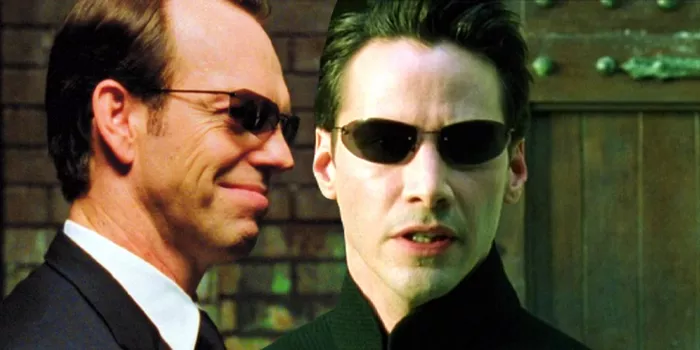Agent Smith’s reappearance in The Matrix Resurrections has sparked intrigue, particularly due to his notable diminishment in power compared to his last appearance in The Matrix Revolutions. Portrayed by Hugo Weaving in the original Matrix trilogy, the fourth installment introduced Jonathan Groff as the new embodiment of Smith, taking on the role of the head of a video game development company overseeing the games created by Thomas Anderson. The narrative unfolds with Anderson utilizing his Matrix memories as inspiration for his latest video game creation. As Neo’s latent abilities resurface upon being unplugged from the Matrix, he is reacquainted with his messiah persona by a group of renegade humans from the real world.
Beyond Smith’s altered appearance, his behavior has also reverted to his earlier characteristics seen in The Matrix. He emerges as a digital gatekeeper and overseer, with Neo ensnared as his monitored prisoner. Prior to their climactic clash in The Matrix Revolutions, Smith had ascended to a potent all-consuming virus, poised to engulf not only every program within the Matrix but also to seize control of The Source itself. However, his new dynamics with the Machines have profoundly curtailed his power, fundamentally altering his programming. The lingering question remains: can he ever regain the formidable might he once possessed, harnessing the combined abilities of the Matrix’s most potent programs?
Agent Smith’s Waning Power in The Matrix Resurrections
The Matrix Resurrections unequivocally showcases Smith’s weakened powers, reflecting a significant loss of potency since his previous appearance in The Matrix Revolutions. No longer the pinnacle of power within the Matrix or a voracious virus, he has been reintegrated into The Source, mirroring the fate of previous exile programs. Smith now functions as a pawn within The Analyst’s scheme, serving as a monitoring tool over Thomas Anderson/Neo and ensuring his adherence to the blue pill illusion.
Reverting to a semblance of his previous role, Smith resembles his past versions, albeit without the conspicuous federal agent appearance. Instead, he oversees the realm of video games at Anderson’s development company. His diminished capabilities serve to keep him subservient to The Analyst’s dominion and in equilibrium with Anderson as his simulated counterpart. Although he retains a degree of influence over the Matrix’s fabric, he is no longer capable of replicating the feats that once defined his clashes with adversaries. This marks a stark contrast to the all-powerful Smith who once dominated the Matrix in his battles against Neo.
The Aftermath of Neo’s Triumph and Smith’s Constraint
In the climactic showdowns spanning The Matrix trilogy, Neo and Smith’s rivalry culminated with Neo’s ascendancy. Their ultimate encounter granted Neo the upper hand, forcing Smith into submission. Following his assimilation of countless Matrix programs and his burgeoning threat to the Machines themselves, a truce was begrudgingly established between Neo and the Machines. Neo’s sacrifice culminated in his annihilation of Smith, ensuring that the menacing virus was eradicated and neutralizing the threat he posed. This sacrifice played a pivotal role in bringing a semblance of harmony between humans and Machines, albeit temporarily until The Analyst orchestrated the Matrix’s revival.
The Analyst’s recalibration of the Matrix hinged upon Neo and Trinity’s enigmatic connection, allowing humans to coexist within the simulation while maintaining the illusion of choice. Smith’s role within this framework necessitated his existence within the Matrix alongside Neo, acting as a counterbalance. However, the Machines were wary of Smith’s resurgence as a rogue program, ensuring that he remained devoid of any means to regain his once-unrivaled potency, including access to The One’s capabilities.
The Prospects of Smith’s Resurgence
Smith’s restoration to full power would likely require circumstances analogous to those in The Matrix Revolutions. His overwhelming potency originated from the assimilation of diverse Matrix programs, culminating in an amalgamation of their unique attributes. The imprinting with Neo during their initial confrontation enabled Smith to absorb the traits of The Architect, The Oracle, Seraph, and others, granting him unparalleled abilities. However, recreating such a scenario might prove challenging, considering the specific conditions that enabled his extraordinary augmentation.
Given Neo’s reclamation of his abilities, the notion of Smith’s partial resurgence remains feasible, especially in the wake of The Analyst’s diminished authority. Notably, Smith played an unexpected role as a guardian during a confrontation between Neo and The Analyst, suggesting that his capabilities could be harnessed for Neo and Trinity’s new Matrix iteration. The sequel’s narrative could potentially facilitate a space for Smith’s restoration, allowing some of the formidable powers he lost in The Matrix Revolutions to be reclaimed.
As the enigma of Smith’s power lingers, The Matrix Resurrections prompts speculation about the extent of his potential resurgence and the complexities surrounding his evolving dynamics within the Matrix universe. The narrative’s progression and revelations remain tightly bound, offering a tantalizing journey for fans to explore the transformation of an iconic character and his role in the larger tapestry of the Matrix saga.
RELEATED READING:
-
Revitalizing the DC Universe: Steering Clear of DCEU Mistakes
-
Marvel Villains Whose MCU Origin Stories Outshine the Comics
-
12 Most Powerful Female MCU Heroes Ranked
-
Prey: Revitalizing Predator Franchise with a Female Lead
-
Hobie Brown: The Coolest Character in Spider-Man: Across the Spider-Verse

